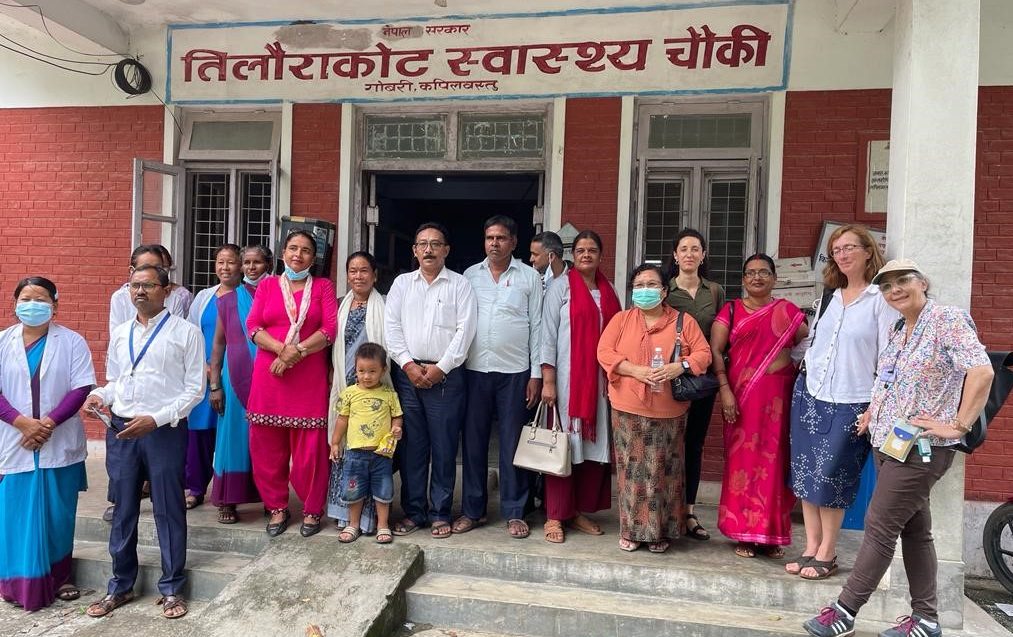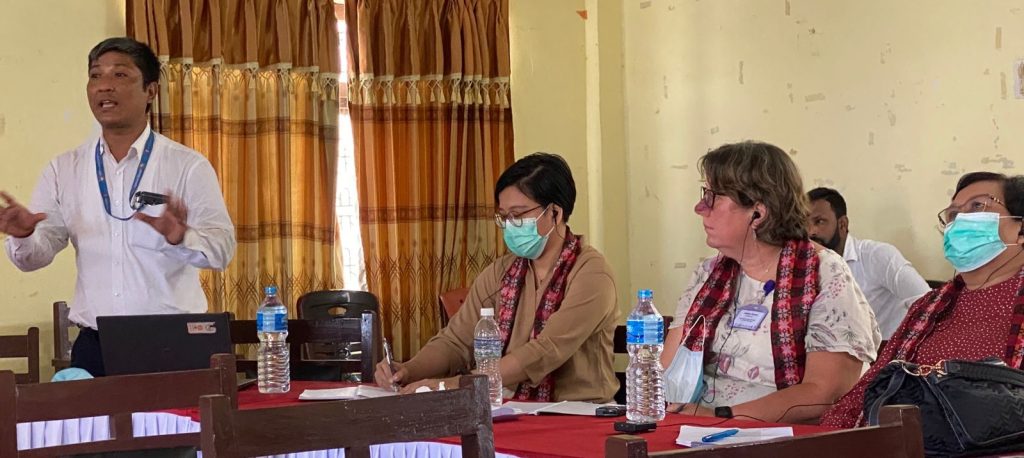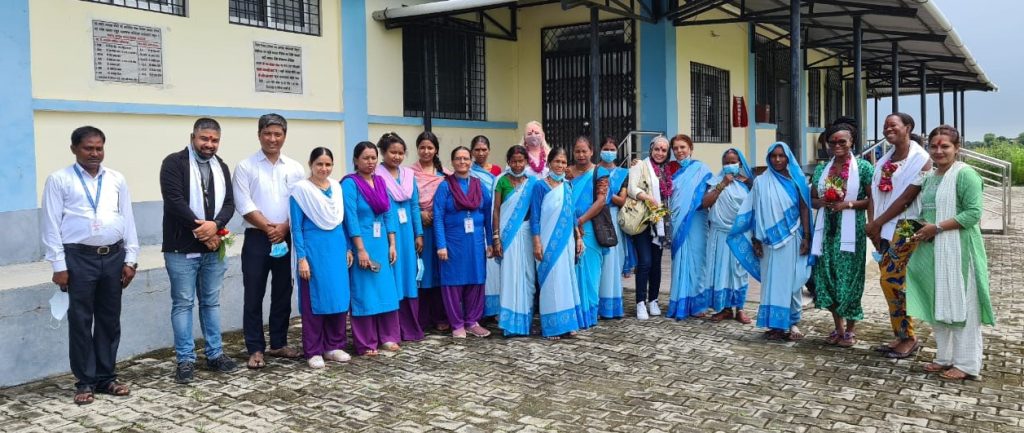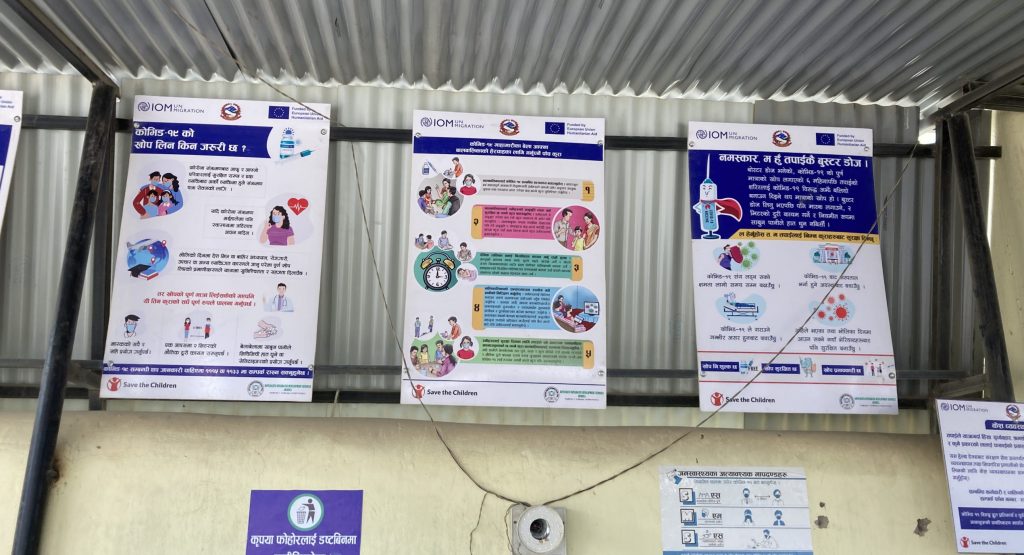
The Health Facility Management Committee at Tilaurakot health post
‘We did our best’ – Resilience in the local health system in response to COVID-19
5 October 2022
In this blog post by Kate Hawkins, Saugat Pratap KC, Shreeman Sharma, Sophie Witter, Karen Miller, Jo Raven and Shophika Regmi, we report from the HERDi learning site in Kapilvastu District, Nepal where ReBUILD for Resilience is implementing embedded health systems research.
“Nobody could have imagined the impact that COVID-19 created. I have been working as a paramedic for 25 years – I have seen floods and outbreaks. We did have small disaster management plans, but we were not prepared for the pandemic.”
Siddhartha Kaji Bajracharya, Health Post in-charge
A recent visit to Kapilvastu, one of the districts in Lumbini Province of Nepal, was an opportunity to hear from elected officials of a local municipality (including mayor, deputy mayor and ward chairs) and health workers on their experiences during the early months of the COVID-19 outbreak in 2020. Their stories demonstrate the resilience of a local health system under strain, as well as the challenges of emergency planning, especially in a decentralised context, and important recommendations for institutional and structural changes.

The REBUILD team hear from those in the municipality involved in the COVID-19 response
When the pandemic hit, Kapilvastu, along with many local government authorities all over the world, found itself unprepared – in terms of human resources, medicines and supplies, infrastructure and information systems, with no obvious mechanism to generate the types of evidence that could help guide the emergency response.
Initially there was little federal guidance on how to respond. In this liminal space, local people had to make quick decisions about how to manage the crisis – innovating and adapting as COVID-19 unfolded.
Governance and communication
At the start of the pandemic there were no official updates through the usual federal government channels. In the absence of formal guidance, health workers and managers found information online, through Facebook and other global sites. While there is the potential for this type of source to broadcast dis- and misinformation, health workers were struggling with how to respond and counsel their constituencies. It was through online sources that they learned about aerosol transmission and isolating people suspected of having COVID-19.
They described chaos in their decision making in a context of rapid threat and information and resource gaps. To overcome this, local-level decisions had to be made by elected representatives as the situation evolved. Some of these decisions may not have been strictly compliant with the federal level but local actors were trying to avoid ‘unmanageable human catastrophe’, and this was made more challenging by the open border with India.
The municipality formed two Rapid Response Teams that each comprise five team members. One was led by a health facility in-charge having a large catchment area, and another was led by a municipal health coordinator. The other team members included a nurse, a lab technician, a health assistant and an auxiliary nurse midwife who worked closely with the ward chair. This municipality has 12 wards. The ward chair is the chair of the Health Facility Operation and Management Committee (HFOMC) in each health facility at ward level, and the Health facility in-charge is the member secretary of HFOMC, and together they quickly mobilized the Female Community Health Volunteers (FCHV). Municipality and ward offices, in coordination with local health facilities, enforced COVID-19 strategies at the local level. For health communication, FCHVs were mobilized, having the support of their communities and particularly close relationships with women and children given their work on maternal health and immunization.

Female Community Health Volunteers (FCHVs) and ReBUILD staff at Jahadi Health Post, Lumbini Province, Nepal
Medicine and supplies
Sourcing test kits and PPE during the initial stages of the pandemic was challenging. Local stakeholders didn’t even have masks at first, and were conducting house visits while frightened of potential infection and the possibility of harming their own families. They described attending patients without even a thermometer to assist with diagnosis. When test kits finally did come through, the PCR results were processed in Kathmandu and took 30 days to come through and this long timeframe hindered planning and action. When PPE did arrive it wasn’t fit for purpose. Health workers described taking 300-400 swabs a day in 35 degree heat inside stifling PPE that couldn’t be removed until the day was over.
Infrastructure
Local-level decision-makers were tasked with opening quarantine centres for people who they suspected were infected with COVID-19. But this was easier said than done as they had no existing infrastructure to use and they were unsure how to isolate people. In the end, they used the school buildings that were closed due to lockdown and quarantined more than 5,000 people in 12 wards. When the weather allowed, people from the isolation centre could stay in the fields outside, but when the heat and rains came there was a serious lack of space inside the building. They also had to run toilet facilities where none had previously existed plus the schools were not accessible for people with disabilities. Caring for Nepali migrant returnees from India was also a challenge as they didn’t have family members to bring them food every day, or had care takers who lived far from Kapilvastu District. This problem was compounded by food shortages at that time. The health workers were also impacted by this and had to work throughout the day fuelled just by fruit, with most shops closed during the lockdown.

Health information at Krishnagar border health facility
On the Nepali-Indian border the arrival of people from India was also an issue. Potentially infected Nepali people were returning home and needed to be tested and cared for, so a new border health check was created at Krishnagar border. At the peak of the pandemic, staff (who themselves fell ill) tested around 300 returnees each day, issuing each infected person with care information. Unfortunately, the majority probably got straight on to public transport, spreading the infection further. This testing facility continues to run, supported by international NGOs, the EU and Kapilvastu Kids, however the nearby new quarantine facility remains unopened due to a lack of funds. (Another problem was migrant returnees entering Nepal via unofficial, unregulated transit points and not being tested.) The border health desks still test for COVID-19, TB, malaria and HIV but on a purely self-referral basis, and samples still need to be sent to Kapilvastu for screening, raising questions over patient and contact tracing and treatment.
Human resources for health
The COVID-19 response relied heavily on the health workforce; a workforce already understaffed and under strain. When these health workers themselves got infected with COVID-19 this was a significant challenge. In one of the health posts all of the staff were infected and it had to be shut down altogether.
The Nepal Police helped with the response, managing the food provided in the quarantine centre and how funds were allocated for this. There was adaptation in the absence of guidance to try and ensure that the poorest were targeted, but because of the lockdown it wasn’t possible to launch a multi-sectoral approach and NGO staff stayed at home until much later in the pandemic.
Local health facilities struggle to provide routine health services on a good day and this was further aggravated when there is an emergency. For instance, this municipality has five primary health centers, but not all sanctioned positions have been filled. Also, around 40% of the municipality’s population live in just four of twelve wards, and with just two health workers to deal with around 9,000 people in each ward the situation is very challenging. Furthermore, Kapilvastu District is prone to disease outbreaks due to several socio-economic and geographic issues. During shocks like COVID-19, local health systems have trouble meeting routine health demands with such emergencies exacerbating the issue. Therefore, the resilience of the local health system is a pressing issue in this municipality.
Looking to the future
The health system was heavily impacted by the pandemic. Immunisation, family planning and nutrition services – the foundations of primary health care – were all put on hold for more than three months. Data collection ceased. When services did resume they took time to get up to speed. In rebuilding the health system, lessons from the outbreak have been incorporated into practice and longer term aspirations:
- Communication during the pandemic cemented the importance of mobile phones. Now the health posts have access to the internet which was not a priority before. Better communications are a key priority for the future.
- In terms of infrastructure and medical supplies, the first stage of the emergency highlighted the need for greater testing and lab capacity, and the scarcity of oxygen in the second phase taught the importance of strengthening hospital care.
- The pandemic highlighted how health emergency decisions by federal governments, such as the decision to impose a lockdown, may have hampered local level coordination and action. Stay-at-home orders prevented a truly multi-sectoral approach and led to a reliance on the police and army where other sectors might have been more appropriate. Restrictive measures based on the local context may be more appropriate.
- During the emergency, the mayors had informal conversations and there was a formal inter- and intra-municipal sharing process. However, there were no mechanisms for sharing lessons learned across municipalities and communicating these stories of adaptation from one local level to another local level and from local level up to the provincial and federal governments. This is still lacking.
- Most of the local level health budget is conditional and this potentially restricts decision making space which is vital in emergencies (although there was a pot of flexible emergency funding that could be used in emergencies). Progressive flexibility could be considered in times of extreme hardship.
ReBUILD with HERD International will continue to document the lessons from the COVID-19 experience, working with municipal partners to identify ways to strengthen the resilience of the local health system, building on the capacities identified and the gaps (for example, around communication), and to share those lessons with other areas and with the district, provincial and national authorities.